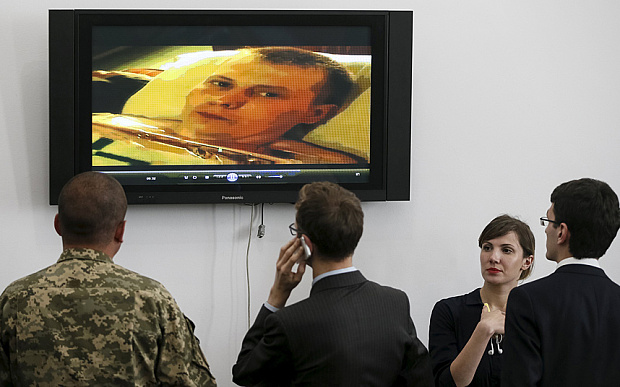
Russian Spetsnaz Personnel Detained in Ukraine
Publication: Eurasia Daily Monitor Volume: 12 Issue: 94
By:

Ukrainian military spokesman, Andriy Lysenko, told a press conference on May 17 that two Russian Spetsnaz (special forces) personnel were arrested by government forces 15 kilometers from Luhansk. The details surrounding the detentions are important to understand Russian actions in southeastern Ukraine. Since the outset of the conflict in Donbas (eastern Ukrainian region encompassing Donetsk and Luhansk provinces), Russian Spetsnaz were at the forefront of military operations. Clearly these forces play a pivotal role in certain Russian operations, while their organization and units have experienced the upheaval of reform in recent years, raising questions as to their future operational roles and their underlying capabilities (Uatoday.tv, May 17).
The initial sketchy details only confirmed that two Russian military intelligence servicemen were detained following clashes between the Ukrainian Armed Forces and the combined Russian-separatist forces close to the town of Shchastya, which is under government control. On the previous day, the Ukrainian Aydar battalion was engaged by Russian military intelligence (GRU) units. According to information leaked through social media, the GRU group attempted to strike against enemy forces during a paratrooper rotation in the 92nd Mechanized Brigade. Ukrainian soldiers detected the advance, resulting in the GRU units losing the element of surprise. And in the ensuing firefight, the commander of a Russian Special Forces Group from the 3rd Brigade was captured along with a Special Forces sergeant. The Russian commander was Captain Yevgeny Yerofeyev, and the deputy commander of the group was Sergeant Alexander Alexandrov. Both were taken captive, with the latter reportedly wounded (Pravda.com.ua, May 17).
Some reporting noted that the Russian military personnel were from Samara. However, as additional details emerged, it seems that both Yerofeyev and Alexandrov were from Tolyatti, which hosts the 3rd Spetsnaz Brigade subordinated to the 41st Army in the Central Military District (MD). It is interesting that specialist units are being deployed in theater from Russia’s strategic reserve district rather than from the Western MD. Moreover, the operation, as far as its reporting indicates, suggests an effort to probe enemy units and locate weaknesses. This is consistent with reform aims in recent years that seek to expand the role played by special forces, from just reconnaissance to encompass wider operational roles, including combat (Pravda.com.ua, Podrobnosti.ua, May 17).
Russia’s special forces, including Spetsnaz and other elite units were involved in the operation in Crimea. And reportedly, GRU Spetsnaz has also operated in the rather different operational environment in southeastern Ukraine. These are mainly acting at platoon strength and are drawn on a rotational basis from 2nd, 22nd, 24th and 100th Spetsnaz Brigades, as well as 346th Brigade under the Special Operations Command. Despite the Kremlin’s persistent use of “plausible deniability,” numerous social media, eye witness and journalistic accounts have indicated that these forces are active on the ground in Donbas (Modern Diplomacy, accessed May 16).
Nonetheless, as the Ukraine conflict has raised the public profile of these elite military units, now synonymous with “polite people,” or “little green men,” despite the years of reform and deeper investment in these forces there is still a sense of organizational chaos within their ranks. A recent article in Voyenno Promyshlennyy Kuryer profiled the reform of Russian special forces since 2009, and drew some interesting conclusions, noting that within these units they regard the period of reform as a “chaotic tossing about,” or simply “chaos” with a commonplace special forces joke being: “First they impoverished us and now we are trying to blossom anew. But for some reason everything fails.” One common feature of the reform of Russian special forces has been experiments, change followed by reversal, and cuts to officer and warrant officer posts. At an early stage in this reform process, for instance, manning by contract and conscript personnel envisaged in a twelve-man group resulted in signing only two or three contract servicemen: the deputy command of the group, a sniper and a communications soldier (Voyenno Promyshlennyy Kuryer, May 13).
In 2009, another novelty appeared in the form of creating special forces battalions in several of the newly formed combined-arms brigades. And even this included a degree of ethnic experimentation. For example, the 19th Motorized Rifle Brigade had such a battalion staffed with Ingush nationals, while its sister units in the 18th and 19th brigades were manned mainly by Chechens. The security demands imposed on Moscow’s planning for the Sochi Olympics in early 2014 led to forming the 346th Special Forces Brigade and the 25th Special Forces Regiment. By 2013, the GRU had reabsorbed Spetsnaz, in another reform reversal, while Spetsnaz officers continued to complain that the main manning problem was the shortage of contract personnel (Voyenno Promyshlennyy Kuryer, May 13).
However, as the author noted: “Despite the return of Spetsnaz units and subunits to the structure of the Main Intelligence Directorate, a paradoxical situation emerged concerning their subordination. For example, the Spetsnaz brigades are subordinate to the GRU, but the various battalions and companies are simultaneously subordinated to the commanders of the brigades and to the army and district chiefs of intelligence, and, in some cases, to the chief of staff and personally to the district commander. Meanwhile, the GRU is responsible for their training as well as, under certain conditions, for their combat application” (Voyenno Promyshlennyy Kuryer, May 13).
According to the article, one of the key tasks for Spetsnaz units remains reconnaissance, now denoted as “special reconnaissance,” which includes monitoring, conducting ambushes and raids and searches deep in the enemy’s rear. Apparently, operations in local conflict zones fall within their remit and their actions and presence in Donbas must be understood in this light. The arrest of the GRU Spetsnaz personnel in southeastern Ukraine is unsurprising. However, their operation beyond the line of contact appears mainly to be in a reconnaissance role, consistent with the combined Russian-separatist forces probing their enemy and with an effort to prepare the battlefield. While it might appear to show some manning- and unit-related issues to reach into Central MD in order to deploy this particular company, it could equally reflect the use of Ukraine as a testing ground for the Russian army; and so, the unit from Tolyatti was selected to offer operational experience to its personnel. But the successful capture of Yerofeyev and Alexandrov shows that even Russia’s most elite units are finding Donbas a substantially different operational environment than Crimea. It is likely that such forces will continue to prepare the battlefield ahead of the next major offensive, depending on whether or not President Vladimir Putin chooses to freeze the conflict.




